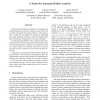Free Online Productivity Tools
i2Speak
i2Symbol
i2OCR
iTex2Img
iWeb2Print
iWeb2Shot
i2Type
iPdf2Split
iPdf2Merge
i2Bopomofo
i2Arabic
i2Style
i2Image
i2PDF
iLatex2Rtf
Sci2ools
ICSE
2009
IEEE-ACM
2009
IEEE-ACM
A toolset for automated failure analysis
Classic fault localization techniques can automatically provide information about the suspicious code blocks that are likely responsible for observed failures. This information is useful, but not sufficient to completely understand the causes of failing executions, which still require further (time-consuming) investigations to be exactly identified. A useful and comprehensive source of information is frequently given by the set of unexpected events that have been observed during failures. Sequences of unexpected events are usually simple to be interpret, and testers can guess the expected correct sequences of events from the faulty sequences. In this paper, we present a tool that automatically identifies anomalous events that likely caused failures, filters the possible false positives, and presents the resulting data by building views that show chains of cause-effect relations, i.e., views that show when anomalous events are caused by other anomalous events. The use of the technique ...
| Added | 17 Nov 2009 |
| Updated | 17 Nov 2009 |
| Type | Conference |
| Year | 2009 |
| Where | ICSE |
| Authors | Fabrizio Pastore, Leonardo Mariani, Mauro Pezzè |
Comments (0)

